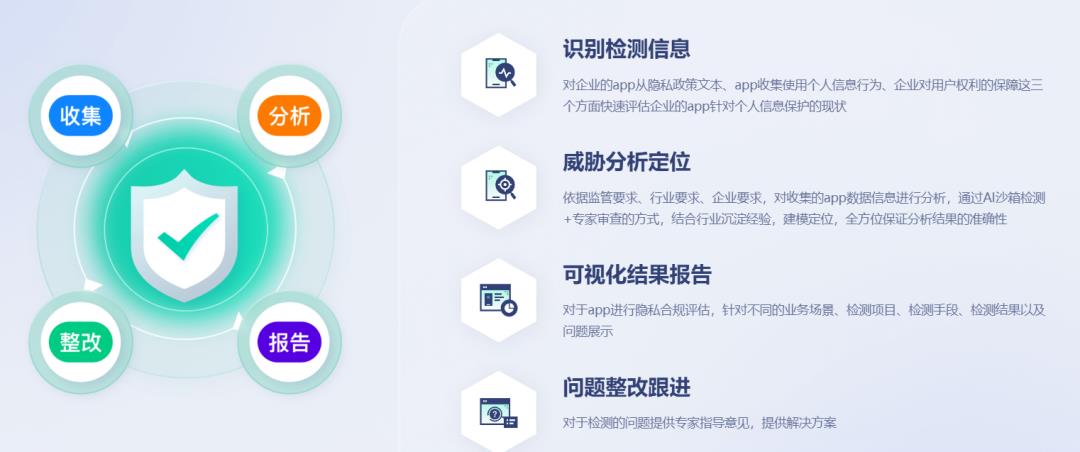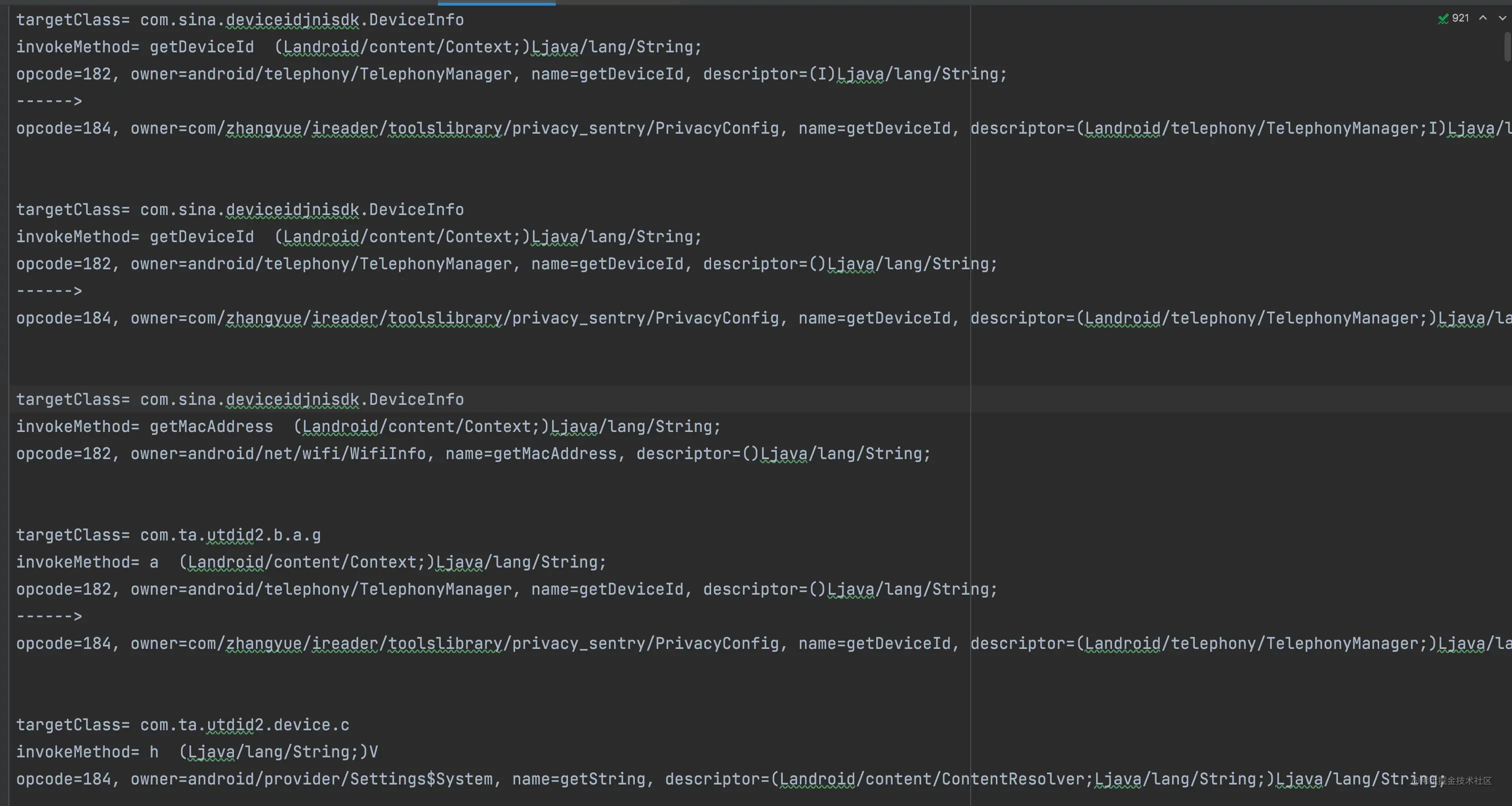顶象推出应用隐私合规检测服务
Posted 顶象技术
tags:
篇首语:本文由小常识网(cha138.com)小编为大家整理,主要介绍了顶象推出应用隐私合规检测服务相关的知识,希望对你有一定的参考价值。

为帮助开发者更高效地进行App隐私合规检测,顶象推出应用隐私合规检测服务,快速发现App可能存在的各类隐私安全漏洞,并提供详细的检测报告,给出专业的合规整改建议。该服务可应用于上架前和合规检测,通过个人信息保护分析、威胁定位分析和可视化结果报告等方式,帮助开发者全方位评估App针对个人信息保护的现状,识别潜在的隐私风险,构建安全可信的高质量App。


App合规性非常重要
近日,工业和信息化部日前通报了2023年第2批侵害用户权益行为的App(SDK)名单,被通报App共55款,涉及强制、频繁、过度索取权限等问题,还有一些消费者难以觉察的如App频繁自启动和关联启动、超范围索权,应用分发平台上App信息明示不到位等问题。从版本上看,安卓应用是重灾区,各大手机应用商店以及各种手机软件助手都有涉及。
监管部门对于App违规的评定依据《数据安全法》《个人信息保护法》《App违法违规收集使用个人信息行为认定方法》《常见类型移动互联网应用程序必要个人信息范围规定》等法律和有关规定来判断。
《App违法违规收集使用个人信息行为认定方法》是由中国互联网信息办公室于2019年11月发布的,旨在规范移动应用程序对用户个人信息的收集、使用、处理等行为。本《规定》共六个要点,分别详细介绍了可被认定为“未公开收集使用规则”的行为,可被认定为“未明示收集使用个人信息的目的、方式和范围”的行为,可被认定为“未经用户同意收集使用个人信息”的行为,可被认定为“违反必要原则,收集与其提供的服务无关的个人信息”的行为,可被认定为“未经同意向他人提供个人信息”的行为,以及可被认定为“未按法律规定提供删除或更正个人信息功能”或“未公布投诉、举报方式等信息”的行为。
《常见类型移动互联网应用程序必要个人信息范围规定》是由工业和信息化部制定的,旨在规范移动应用程序收集、使用用户个人信息时的范围。对常见App收集个人信息的必要限度作出了列举性规定,划清了红线。明确App运营者不得因用户不同意收集非必要个人信息,而拒绝用户使用App基本功能服务,不同App的必要个人信息范围,与它们的基本功能服务密切相关。

隐私合规检测助力App合规
为了帮助开发者更高效地进行App隐私合规检测,聚焦更多的精力构建功能齐全、用户体验良好的高质量App,顶象推出应用隐私合规检测服务。
该服务基于顶象内部积累多年的App隐私合规检测能力,帮助开发者发现App可能存在的各类隐私安全漏洞,提供详细的检测报告,并给出专业的合规整改建议。同时,顶象专业的隐私安全专家团队,还为开发者提供一对一专家咨询服务,帮助开发者高效检测,快速识别App潜在的隐私风险,构建安全可信的高质量App。
顶象应用隐私合规检测服务可以应用于上架前和合规检测。
上架前隐私检测。在各个移动应用市场在应用上架前,对App进行隐私检测,确保安全合规、发现存在的风险。
应用合规检测。基于多个监管文件,进行App日常合规检测、整改、二次检测和抽检等,防止对客户信息过度收集。
顶象应用隐私合规检测服务提供个人信息保护现状,威胁定位分析和可视化结果报告。

个人信息保护分析。从隐私政策文本、App收集使用个人信息行为、企业对用户权利的保障等三个方面,快速评估App针对个人信息保护的现状。
威胁分析定位。依据监管、行业、企业,对App收集的数据信息进行分析,通过AI沙箱检测+专家审查的方式,结合行业沉淀经验,建模定位,全方位保证分析结果的准确性。
可视化报告。通过全方位的隐私合规评估后,提供业务场景、检测项目、检测手段、检测结果以及问题展示。
问题整改跟进。对于检测的问题提供专家指导意见,提供解决方案。
现在登录(www.dingxiang-inc.com/business/compliance)即可了解详情(点击阅读原文即可直达)。

合规检测对开发者的帮助
顶象应用隐私合规检测服务应用隐私合规检测服务对于应用程序开发者来说非常重要,可以帮助他们保护用户个人信息安全和隐私,保证应用程序的合规性和可靠性,提高应用程序的市场竞争力,并节省开发成本和时间。
1、保证应用程序的合规性和可靠性。监管部门对于应用程序合规运营的监管力度也在逐步加强,开发者需要遵守相关法规和规定,保证应用程序的合规性和用户体验,创造更加安全、可靠、有价值的应用程序服务。应用隐私合规检测服务可以帮助开发者全方位评估应用程序针对个人信息保护的现状,发现问题并及时整改,确保应用程序的合规性和可靠性。
2、提高应用程序的市场竞争力。如今,隐私安全成为越来越多用户选择应用程序的一个重要因素。保护用户个人信息安全和隐私可以增强用户对应用程序的信任,提高用户留存率和用户体验,从而提高应用程序的市场竞争力。应用隐私合规检测服务可以帮助开发者构建隐私安全的应用程序,提高应用程序的市场竞争力。
3、节省开发成本和时间。应用隐私合规检测服务为开发者提供了详细的检测报告和专业的合规整改建议,帮助开发者快速识别应用程序存在的问题,并提供解决方案。这可以帮助开发者节省开发成本和时间,提高开发效率。
业务安全大讲堂:立即报名
业务安全产品:免费试用
业务安全交流群:加入畅聊
ASM 字节码插桩:隐私合规方法检测
1.前言
近两年来工信部对于应用的隐私合规安全问题愈加重视,对 Android 平台的管控程度也要比 IOS 平台严格很多,很多不合规的应用也先后被下架要求整改。笔者就曾遇到过加班整改隐私合规的问题,隐私合规问题主要针对两个方面。
- 在用户同意隐私协议之前不能收集用户隐私数据,例如
IMEI、AndroidId、MAC等 - 在用户同意隐私协议之后,收集用户数据行为在对应场景不能超频。比如一分钟不能超过 3 次获取
IMEI
针对上述两个方面,有以下措施来针对
- 通过静态扫描,收集项目中(自有代码 + 三方
sdk)使用隐私合规相关api的相关代码 - 通过
ASM插桩,在调用隐私合规api之前插入代码,记录运行时的方法调用链和当前时间 hook隐私合规api,替换字节码指令将调用链指向工具类,在未同意隐私协议之前,不调用相关的api
2.实现
2.1 注解和工具类
通过定义注解和工具类,用来定义要处理哪些隐私合规相关的方法,目前笔者已经处理了大部分,请放心食用
2.1.1 注解
/**
* 收集和注解匹配的方法
* visitMethodInsn(int opcode, String owner, String name,String desc)
*
* ======如果 originName 和 originDesc 传"",逻辑会在插件中处理=====
*/
@Retention(RetentionPolicy.CLASS)
@Target(ElementType.METHOD)
public @interface AsmMethodReplace
/**
* 指令操作码
*/
int targetMethodOpcode();
/**
* 方法所有者类
*/
String targetClass();
/**
* 方法名称
*/
String targetName() default "";
/**
* 方法描述符
*/
String targetDesc() default "";
/**
* 是否进行 hook
*/
boolean hook() default false;
该注解用来匹配调用隐私合规 api 的字节码指令,例如通过 ASM 调用 getImei 的字节码指令为
methodVisitor.visitMethodInsn(INVOKEVIRTUAL, "android/telephony/TelephonyManager", "getImei", "()Ljava/lang/String;", false);。targetName 属性和 targetDesc 可以不赋值,这里做了取巧的处理,会根据工具类的 method name 和method descriptor 推断出调用隐私合规方法的字节码指令,这块后面插件会处理。
最后的 hook 属性表示是否 hook 掉原始的调用链,将调用指向工具类中的方法。
2.1.2 工具类
上述注解可以用在任何地方,笔者将常用的隐私合规的方法聚合起来,方法工具类中统一处理,例如处理 IMEI 的逻辑如下:
@RequiresApi(api = Build.VERSION_CODES.O)
@AsmMethodReplace(targetMethodOpcode = OPCODE_INVOKEVIRTUAL
, targetClass = CLASS_NAME_TELEPHONYMANAGER,hook = true)
public static String getImei(TelephonyManager telephonyManager)
if (!checkAgreePrivacy("getImei"))
Log.e(TAG, TIP);
return "";
if (Build.VERSION.SDK_INT >= Build.VERSION_CODES.Q)
Log.i(TAG, "getImei-SDK_INT above android Q");
return "";
return telephonyManager.getImei();
如果还没有同意隐私协议,直接 return “”,否者走正常的调用方法。同时,通过工具类
@Override
protected void attachBaseContext(Context base)
super.attachBaseContext(base);
ConfigGlobal.getInstance().setStoreDirectory(base.getExternalCacheDir().getAbsolutePath());
设置存储调用堆栈和时间的文件路径。
2.2 插件处理
gradle 插件的基本使用在这里就不赘述了,这里主要是两方面的处理
编译时扫描代码,处理有定义特定注解的方法,分析字节码指令,收集所有需要处理的隐私合规相关 api 相关的信息
再次扫描,根据第一次扫描收集到的信息,判断当前类是否含有调用隐私合规 api 的字节码指令,如果有,在该类中注入一个写文件方法及在隐私合规 api 调用指令之前插入写文件的字节码指令,用来记录调用堆栈和频次。
2.2.1 模版代码
下面这块代码是我们在自定义 gradle 插件时常用的模版代码,供大家使用
package com.zhangyue.ireader
import com.android.build.api.transform.*
import com.android.build.gradle.internal.pipeline.TransformManager
import com.zhangyue.ireader.plugin_privacy.PrivacyGlobalConfig
import com.zhangyue.ireader.util.CommonUtil
import com.zhangyue.ireader.util.Logger
import org.apache.commons.io.FileUtils
import org.apache.commons.io.IOUtils
import org.gradle.api.Project
import java.util.concurrent.AbstractExecutorService
import java.util.concurrent.Callable
import java.util.concurrent.ForkJoinPool
import java.util.jar.JarEntry
import java.util.jar.JarFile
import java.util.jar.JarOutputStream
abstract class BaseTransform extends Transform
AbstractExecutorService executorService = ForkJoinPool.commonPool()
private List<Callable<Void>> taskList = new ArrayList<>()
protected Project project
BaseTransform(Project project)
this.project = project
@Override
String getName()
return getClass().simpleName
@Override
Set<QualifiedContent.ContentType> getInputTypes()
return TransformManager.CONTENT_CLASS
@Override
Set<? super QualifiedContent.Scope> getScopes()
return TransformManager.SCOPE_FULL_PROJECT
@Override
boolean isIncremental()
return true
@Override
void transform(TransformInvocation transformInvocation) throws TransformException, InterruptedException, IOException
super.transform(transformInvocation)
println("transform start--------------->")
if (firstTransform())
printCopyRight()
onTransformStart(transformInvocation)
def startTime = System.currentTimeMillis()
def inputs = transformInvocation.inputs
def outputProvider = transformInvocation.outputProvider
def context = transformInvocation.context
def isIncremental = transformInvocation.isIncremental()
if (!isIncremental)
outputProvider.deleteAll()
//1
// inputs.each input ->
// input.jarInputs.each JarInput jarInput ->
// forEachJar(jarInput, outputProvider, context, isIncremental)
//
//
// input.directoryInputs.each DirectoryInput dirInput ->
// forEachDir(dirInput, outputProvider, context, isIncremental)
//
//
//3
inputs.each input ->
input.jarInputs.each jarInput ->
submitTask(new Runnable()
@Override
void run()
forEachJar(jarInput, outputProvider, context, isIncremental)
)
input.directoryInputs.each DirectoryInput dirInput ->
submitTask(new Runnable()
@Override
void run()
forEachDir(dirInput, outputProvider, context, isIncremental)
)
def futures = executorService.invokeAll(taskList)
futures.each it ->
it.get()
onTransformEnd(transformInvocation)
println(getName() + "transform end--------------->" + "duration : " + (System.currentTimeMillis() - startTime) + " ms")
void submitTask(Runnable runnable)
taskList.add(new Callable<Void>()
@Override
Void call() throws Exception
runnable.run()
return null
)
void forEachDir(DirectoryInput directoryInput, TransformOutputProvider outputProvider, Context context, boolean isIncremental)
def inputDir = directoryInput.file
File dest = outputProvider.getContentLocation(
directoryInput.name,
directoryInput.contentTypes,
directoryInput.scopes,
Format.DIRECTORY
)
println "directoryInputPath:" + directoryInput.file.absolutePath
println "destPath:" + dest.absolutePath
def srcDirPath = inputDir.absolutePath
def destDirPath = dest.absolutePath
def temporaryDir = context.temporaryDir
FileUtils.forceMkdir(dest)
Logger.info("srcDirPath:$srcDirPath, destDirPath:$destDirPath")
if (isIncremental)
directoryInput.getChangedFiles().each entry ->
def classFile = entry.key
switch (entry.value)
case Status.NOTCHANGED:
Logger.info("处理 class: " + classFile.absoluteFile + " NOTCHANGED")
break
case Status.REMOVED:
Logger.info("处理 class: " + classFile.absoluteFile + " REMOVED")
//最终文件应该存放的路径
def destFilePath = classFile.absolutePath.replace(srcDirPath, destDirPath)
def destFile = File(destFilePath)
if (destFile.exists())
destFile.delete()
break
case Status.ADDED:
case Status.CHANGED:
Logger.info("处理 class: " + classFile.absoluteFile + " ADDED or CHANGED")
modifyClassFile(classFile, srcDirPath, destDirPath, temporaryDir)
break
default:
break
else
com.android.utils.FileUtils.getAllFiles(inputDir).each File file ->
modifyClassFile(file, srcDirPath, destDirPath, temporaryDir)
void modifyClassFile(classFile, srcDirPath, destDirPath, temporaryDir)
Logger.info("处理 class: " + classFile.absoluteFile)
//目标路径
def destFilePath = classFile.absolutePath.replace(srcDirPath, destDirPath)
def destFile = new File(destFilePath)
if (destFile.exists())
destFile.delete()
Logger.info("处理 class: destFile" + destFile.absoluteFile)
String className = CommonUtil.path2ClassName(classFile.absolutePath.replace(srcDirPath + File.separator, ""))
Logger.info("处理 className: " + className)
File modifyFile = null
if (CommonUtil.isLegalClass(classFile) && shouldHookClass(className))
modifyFile = getModifyFile(classFile, temporaryDir, className)
if (modifyFile == null)
modifyFile = classFile
FileUtils.copyFile(modifyFile, destFile)
File getModifyFile(File classFile, File temporaryDir, String className)
byte[] sourceBytes = IOUtils.toByteArray(new FileInputStream(classFile))
def tempFile = new File(temporaryDir, CommonUtil.generateClassFileName(classFile))
if (tempFile.exists())
FileUtils.forceDelete(tempFile)
def modifyBytes = modifyClass(className, sourceBytes)
if (modifyBytes == null)
modifyBytes = sourceBytes
tempFile.createNewFile()
def fos = new FileOutputStream(tempFile)
fos.write(modifyBytes)
fos.flush()
IOUtils.closeQuietly(fos)
return tempFile
void forEachJar(JarInput jarInput, TransformOutputProvider outputProvider, Context context, boolean isIncremental)
Logger.info("jarInput:" + jarInput.file)
File destFile = outputProvider.getContentLocation(
//防止同名被覆盖
CommonUtil.generateJarFileName(jarInput.file), jarInput.contentTypes, jarInput.scopes, Format.JAR)
//增量编译处理
if (isIncremental)
Status status = jarInput.status
switch (status)
case Status.NOTCHANGED:
Logger.info("处理 jar: " + jarInput.file.absoluteFile + " NotChanged")
//Do nothing
return
case Status.REMOVED:
Logger.info("处理 jar: " + jarInput.file.absoluteFile + " REMOVED")
if (destFile.exists())
FileUtils.forceDelete(destFile)
return
case Status.ADDED:
case Status.CHANGED:
Logger.info("处理 jar: " + jarInput.file.absoluteFile + " ADDED or CHANGED")
break
if (destFile.exists())
FileUtils.forceDelete(destFile)
CommonUtil.isLegalJar(jarInput.file) ? transformJar(jarInput.file, context.getTemporaryDir(), destFile)
: FileUtils.copyFile(jarInput.file, destFile)
def transformJar(File jarFile, File temporaryDir, File destFile)
Logger.info("处理 jar: " + jarFile.absoluteFile)
File tempOutputJarFile = new File(temporaryDir, CommonUtil.generateJarFileName(jarFile))
if (tempOutputJarFile.exists())
FileUtils.forceDelete(tempOutputJarFile)
JarOutputStream jarOutputStream = new JarOutputStream(new FileOutputStream(tempOutputJarFile))
JarFile inputJarFile = new JarFile(jarFile, false)
try
def entries = inputJarFile.entries()
while (entries.hasMoreElements())
def jarEntry = entries.nextElement()
def entryName = jarEntry.getName()
def inputStream = inputJarFile.getInputStream(jarEntry)
try
byte[] sourceByteArray = IOUtils.toByteArray(inputStream)
def modifiedByteArray = null
if (!jarEntry.isDirectory() && CommonUtil.isLegalClass(entryName))
String className = CommonUtil.path2ClassName(entryName)
if (shouldHookClass(className))
modifiedByteArray = modifyClass(className, sourceByteArray)
if (modifiedByteArray == null)
modifiedByteArray = sourceByteArray
jarOutputStream.putNextEntry(new JarEntry(entryName))
jarOutputStream.write(modifiedByteArray)
jarOutputStream.closeEntry()
finally
IOUtils.closeQuietly(inputStream)
finally
jarOutputStream.flush()
IOUtils.closeQuietly(jarOutputStream)
IOUtils.closeQuietly(inputJarFile)
FileUtils.copyFile(tempOutputJarFile, destFile)
private byte[] modifyClass(String className, byte[] sourceBytes)
byte[] classBytesCode
try
classBytesCode = hookClassInner(className, sourceBytes)
catch (Throwable e)
e.printStackTrace()
classBytesCode = null
println "throw exception when modify class $className"
return classBytesCode
/**
* 打印日志信息
*/
static void printCopyRight()
println()
println '#######################################################################'
println '########## '
println '########## 欢迎使用隐私合规处理插件'
println '########## '
println '#######################################################################'
println '########## '
println '########## 插件配置参数 '
println '########## '
println '########## -isDebug: ' + PrivacyGlobalConfig.isDebug
println '########## -handleAnnotationName: ' + PrivacyGlobalConfig.handleAnnotationName
println '########## -exclude: ' + PrivacyGlobalConfig.exclude
println '########## '
println '########## '
println '########## '
println '#######################################################################'
println()
protected boolean firstTransform()
return false
boolean shouldHookClass(String className)
def excludes = PrivacyGlobalConfig.exclude
if (excludes != null)
for (String string : excludes)
if (className.startsWith(string))
return false
return shouldHookClassInner(className)
protected abstract boolean shouldHookClassInner(String className)
protected abstract byte[] hookClassInner(String className, byte[] bytes)
protected abstract void onTransformStart(TransformInvocation transformInvocation)
protected abstract void onTransformEnd(TransformInvocation transformInvocation)
2.2.2 注解处理 transform
收集和处理具有特定注解的字节码指令,给下一个 transform 使用
@Override
byte[] hookClassInner(String className, byte[] bytes)
ClassReader cr = new ClassReader(bytes)
ClassNode classNode = new ClassNode()
cr.accept(classNode, 0)
classNode.methods.each methodNode ->
//编译期注解
methodNode.invisibleAnnotations.
each annotationNode ->
if (PrivacyGlobalConfig.getHandleAnnotationName() == annotationNode.desc)
collectPrivacyMethod(annotationNode, methodNode, cr.className)
return bytes
/**
* 收集注解和注解关联的方法
* @param annotationNode 注解信息
* @param methodNode 方法信息
*/
static collectPrivacyMethod(AnnotationNode annotationNode, MethodNode methodNode, String className)
List<Object> values = annotationNode.values
Logger.info("annotation values : $values")
MethodReplaceItem item = new MethodReplaceItem(values, methodNode, CommonUtil.getClassInternalName(className))
PrivacyGlobalConfig.methodReplaceItemList.offer(item)
Logger.info("collectPrivacyMethod success: $item")
println("collectPrivacyMethod success: $item")
MethodReplaceItem中封装了收集到的字节码属性,同时会根据注解关联方法的字节码指令推断出想要处理的隐私合规 api 的字节码指令。
MethodReplaceItem(List<Object> annotationPair, MethodNode methodNode, String owner)
replaceOpcode = Opcodes.INVOKESTATIC
replaceClass = owner
replaceMethod = methodNode.name
replaceDesc = methodNode.desc
for (int i = 0; i < annotationPair.size(); i = i + 2)
def key = annotationPair[i]
def value = annotationPair[i + 1]
if (key == "targetMethodOpcode")
targetOpcode = value
else if (key == "targetClass")
targetOwner = value
else if (key == "targetName")
targetMethod = value
else if (key == "targetDesc")
targetDesc = value
else if(key == "hook")
willHook = value
Logger.info("=====targetOpcode:$targetOpcode,targetOwner:$targetOwner , replaceDesc$replaceDesc")
if (isEmpty(targetMethod))
targetMethod = replaceMethod
if (isEmpty(targetDesc))
//静态方法,oriDesc 跟 targetDesc 一样
if (targetOpcode == Opcodes.INVOKESTATIC)
targetDesc = replaceDesc
else
//非静态方法,约定第一个参数是实例类名,oriDesc 比 targetDesc 少一个参数,处理一下
// (Landroid/telephony/TelephonyManager;)Ljava/lang/String -> ()Ljava/lang/String
def param = replaceDesc.split('\\)')[0] + ")"
def result = replaceDesc.split('\\)')[1]
def index = replaceDesc.indexOf(targetOwner)
if (index != -1)
param = "(" + param.substring(index + targetOwner.length() + 1)
Logger.info("index::: $index")
targetDesc = param + result
2.2.3 合规方法处理 transform
再次扫描整个项目,根据在上一个 transform 中收集到的要处理的隐私合规的 api,遍历字节码指令,当匹配上时,在当前的类中注入写文件的方法,同时在调用隐私合规的字节码指令前插入写文件的字节码指令,用来记录。
@Override
byte[] hookClassInner(String className, byte[] bytes)
Logger.info("$getName() modifyClassInner--------------->")
def findHookPoint = false
Map<MethodNode, InsertInsnPoint> collectMap = new HashMap<>()
ClassReader cr = new ClassReader(bytes)
ClassNode classNode = new ClassNode()
cr.accept(classNode, ClassReader.EXPAND_FRAMES)
classNode.methods.each methodNode ->
//过滤掉含有特定注解的方法
if (isNotHookMethod(cr.className, methodNode))
methodNode.instructions.each insnNode ->
//判断字节码能否匹配
def methodReplaceItem = searchHookPoint(insnNode)
if (methodReplaceItem != null)
//判断是否需要 hook 掉当前指令
def inject = methodReplaceItem.willHook
//记录隐私合规 api 所在的类及方法
logHookPoint(classNode.name, methodReplaceItem, methodNode, insnNode.opcode, insnNode.owner, insnNode.name, insnNode.desc, inject)
if (inject)
//hook
injectInsn(insnNode, methodReplaceItem)
//插入写文件方法指令,收集调用隐私方法的堆栈
collectInsertInsn(insnNode, methodNode, classNode, collectMap, inject)
findHookPoint = true
if (!collectMap.isEmpty() && findHookPoint)
//插入写文件指令,用来展示堆栈信息
collectMap.each key, value ->
key.instructions.insert(value.hookInsnNode, value.instList)
//插入 writeToFile 方法
ClassWriter cw = new ClassWriter(ClassWriter.COMPUTE_MAXS)
classNode.accept(cw)
insertWriteToFileMethod(cw)
return cw.toByteArray()
return bytes
在 collectInsertInsn 方法中,通过 throwable 来收集当前的堆栈.
/**
* 收集 在调用特定的方法前插入调用写入文件的方法的指令
* @param insnNode
* @param methodNode
* @param classNode
* @param collectMap
*/
static void collectInsertInsn(insnNode, methodNode, classNode, collectMap, Inject)
def className = classNode.name
def methodName = methodNode.name
def methodDesc = methodNode.desc
def owner = null
def name = null
def desc = null
if (insnNode instanceof MethodInsnNode)
owner = insnNode.owner
name = insnNode.name
desc = insnNode.desc
//------log
StringBuilder lintLog = new StringBuilder()
lintLog.append(className)
lintLog.append(" -> ")
lintLog.append(methodName)
lintLog.append(" -> ")
lintLog.append(methodDesc)
lintLog.append("\\r\\n")
lintLog.append(owner)
lintLog.append(" -> ")
lintLog.append(name)
lintLog.append(" -> ")
lintLog.append(desc)
//------要插入字节码指令
lintLog.append("\\r\\n")
InsnList insnList = new InsnList()
insnList.add(new LdcInsnNode(lintLog.toString()))
insnList.add(new TypeInsnNode(Opcodes.NEW, "java/lang/Throwable"))
insnList.add(new InsnNode(Opcodes.DUP))
insnList.add(new MethodInsnNode(Opcodes.INVOKESPECIAL, "java/lang/Throwable", "<init>", "()V", false))
insnList.add(new MethodInsnNode(Opcodes.INVOKESTATIC, className, writeToFileMethodName, writeToFileMethodDesc))
println "插入指令完成 =---------->"
collectMap.put(methodNode, new InsertInsnPoint(insnList, insnNode))
最终,在项目编译完成之后,会在项目的根目录下生成 replaceInsn.txt 文件,记录包含隐私合规 api 的类和相关方法。

当项目运行起来之后,会在设置的路径中(笔者设置在 getExternalCacheDir 中)生成 privacy_log.txt 文件,里面会记录隐私合规 api 的调用堆栈和时间,根据该调用链,我们就可以快速定位是哪一块业务执行了敏感操作。

总结
通过 ASM + gradle plugin ,能够排查出大部分的隐私合规问题。有什么不足之处,也请读者多多提意见和建议。
作者:season_y
链接:https://juejin.cn/post/7128724162645852168
来源:稀土掘金
以上是关于顶象推出应用隐私合规检测服务的主要内容,如果未能解决你的问题,请参考以下文章